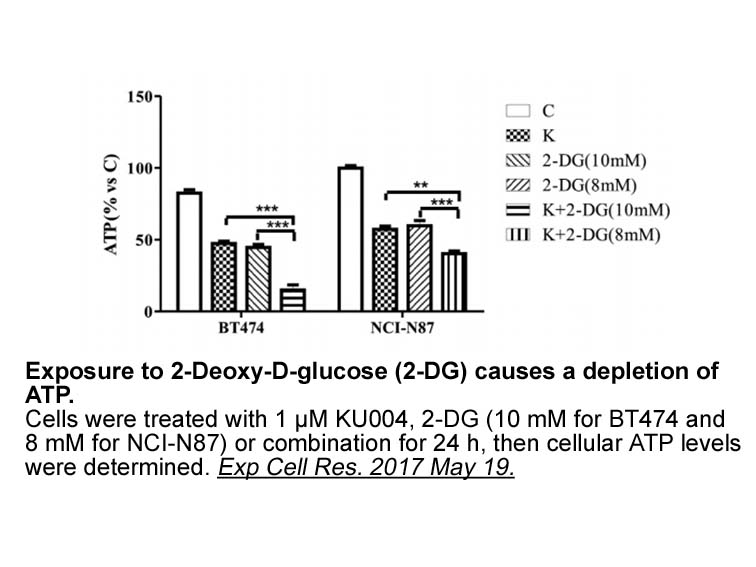Archives
46619 In another study authors found that ADORA were present
In another study, authors found that ADORA1 were present on the intrinsically photosensitive retinal ganglion 46619 (ipRGCs), and application of adenosine to rat retinas reduced light-evoked spiking of ipRGCs through suppression of a cAMP-mediated pathway (Sodhi and Hartwick, 2014). The ipRGCs are a small subset of mammalian retinal ganglion cells that are directly sensitive to light through the activation of melanopsin (see review by Lucas, 2013). The ipRGCs are primarily involved in non-image forming functions, including regulation of pupil size and circadian rhythm entrainment. The ipRGCs have synaptic connections to biopolar cells, as well as amacrine cells, and have been shown to reciprocally modulate dopamine, which has known roles in myopic eye growth (Hannibal et al., 2017; Ostergaard et al., 2007). Localization of ADORs to the ganglion cell layer in Rhesus monkeys, along with previous evidence for a role of adenosine in ipRGC signaling, may implicate this pathway as a potential modulator for myopic eye growth. Further investigation of ipRGC function and eye growth in animals treated with adenosine receptor agonists and antagonists may help to clarify these interactions.
ADORs modulate blood flow, most likely by stimulating vasodilation (Polska et al., 2003). Adenosine infusion increases choroidal blood flow in cats (Portellos et al., 1995), though which ADOR is responsible for this effect is not fully established. A recent study in humans showed that acute oral administration of caffeine causes thinning of the choroid from 30 min to 4 h after intake (Altinkaynak et al., 2016). Conversely, a recent study in Rhesus monkeys showed that long-term (150 day) oral administration of 7-MX resulted in chronic thickening of the choroid, accompanied by a decrease in experimental myopia (Hung et al., 2018). In the CNS, acute and chronic effects of caffeine differ significantly, presumably because chronic administration of caffeine causes differential regulation of ADOR1 and ADORA2a (Brito et al., 2016; Karcz-Kubicha et al., 2003). The choroid is a critical component in the vision-dependent cascade of structural changes in myopic eye growth (Nickla, 2006). However, the mechanism by which the thickness of the choroid is modulated has not been elucidated. With immunostaining, ADORA2a, A2b and A3 were localized to the choroid. The observation of ADORs in the choroid itself leaves open the possibility that methylxanthines may target the choroid directly.
Here, ADORA2a, ADORA2b, and ADORA3 expression was localized to the sclera. In rabbits, chronic treatment with 7-MX resulted in an increase in scleral collagen content and increased collagen fibril diameter in the posterior sclera (Trier et al., 1999). A previous study found all four types of ADORs in human scleral fibroblasts (Cui et al., 2008). These findings may suggest a direct role of methylxanthines in preventing scleral remodeling in response to myopia-inducing visual stimuli in experimental animals.
In this study, ADOR immunoreactivity was noted in all three layers of the cornea. ADORA2b expression was especially interesting, as it was localized in the basal layer of the corneal epithelium and in the limbal rete pegs, the source of corneal stem cells. Adenosine and ADORA2a play a critical role in the differentiation of stem cells (Kang et al., 2018; Katebi et al., 2009), but the role of ADORA2b in stem cells is unknown. The cornea and sclera are fibrous connective tissues composed of collagen fibers and specialized fibroblasts (“keratocytes” in the cornea). The primary structural difference between the cornea and sclera consists in the arrangement of the collagen fibers: regularly-arranged collagen lamellae confer transparency, whereas irregu larly arranged fibers confer opacity. Because of this similar composition, it is possible that the changes previously noted in sclera following methylxanthine treatment may occur in the cornea as well. Thus it would be relevant to evaluate whether methylxanthine treatment causes changes in corneal thickness, corneal stem cell viability, and corneal collagen fibril diameter. In Rhesus monkeys, oral 7-MX treatment did not alter corneal power or curvature (Hung et al., 2018), indicating that any changes to the cornea are optically unimportant. However, if methylxanthines are shown to increase corneal thickness or corneal collagen fibril diameter, they may also prove useful in non-surgical treatment of corneal ectasias such as keratoconus.
larly arranged fibers confer opacity. Because of this similar composition, it is possible that the changes previously noted in sclera following methylxanthine treatment may occur in the cornea as well. Thus it would be relevant to evaluate whether methylxanthine treatment causes changes in corneal thickness, corneal stem cell viability, and corneal collagen fibril diameter. In Rhesus monkeys, oral 7-MX treatment did not alter corneal power or curvature (Hung et al., 2018), indicating that any changes to the cornea are optically unimportant. However, if methylxanthines are shown to increase corneal thickness or corneal collagen fibril diameter, they may also prove useful in non-surgical treatment of corneal ectasias such as keratoconus.